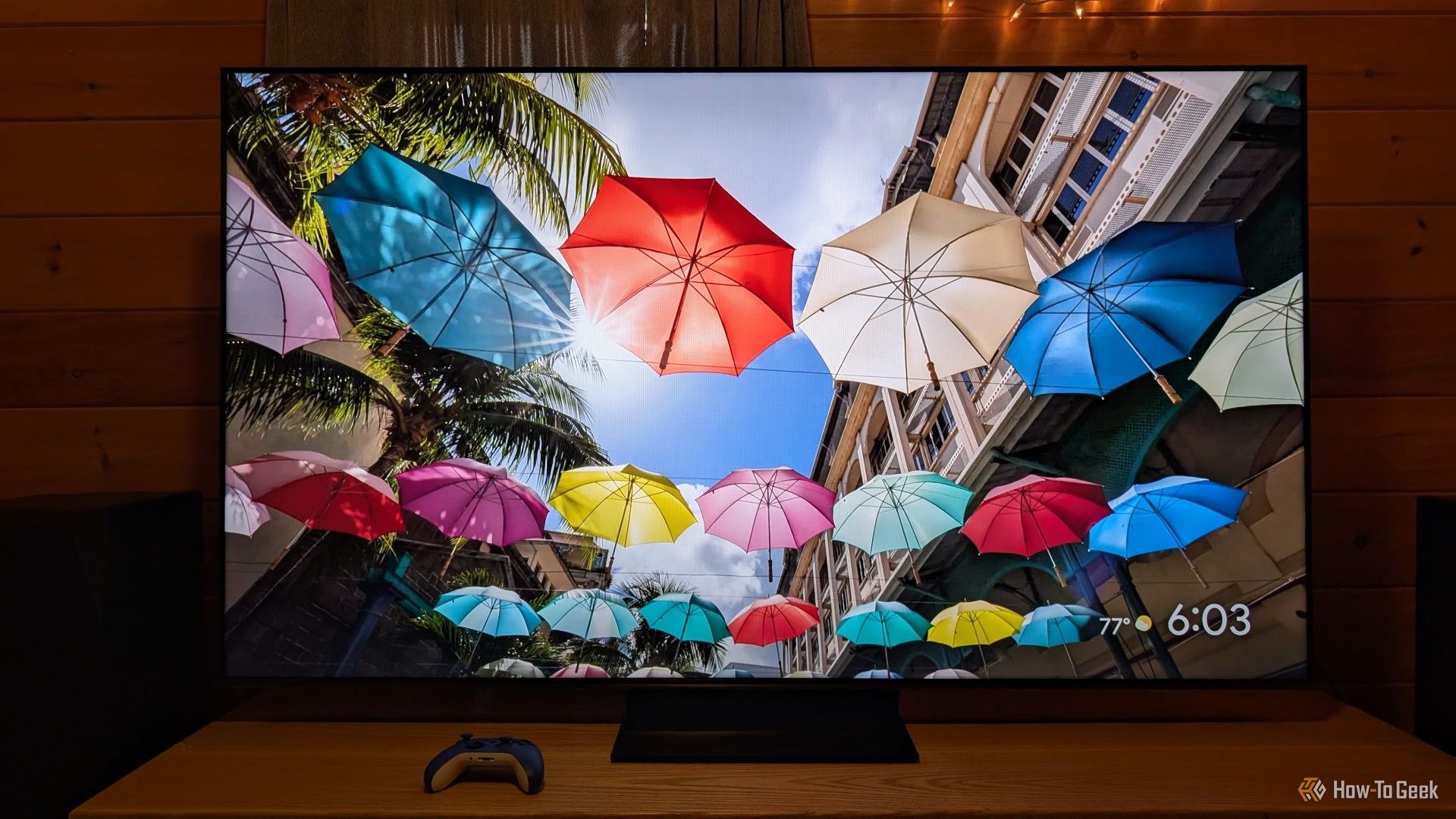The Hisense 75U75QG is one of the best televisions in its price range due to its brilliant colors, incredible maximum brightness, and numerous dimming zones. As an added perk, the sound system is pretty great, too.
- Brand
-
Hisense
- Display Size
-
75-inches
- Dimensions
-
65.7×37.9×3 inches
The Hisense U75QG 4K Google TV is a miniLED display with a vibrant image with incredible contrast thanks to a high peak brightness combined with thousands of local dimming zones.It also features a very capable 2.1.2 sound system built in.
- Incredible Maximum Brightness
- Good Integrated Sound
- Vibrant, Engaging Colors
- Color Settings Required Some Tweaking
- AI Features Are Not Very Helpful
Price and Availability
The Hisense U7QG is available in 55-, 65-, 75-, 85-, and 100-inch variants. I reviewed the 75U7QG, which is the 75-inch variant.
The normal sale price of the 75-inch unit is $1,999, though you sometimes find it discounted as low as $1098. The average price tends to float around $1,400 dollars.
You can buy the TVs in the U7GQ lineup from Best Buy, Walmart, and Amazon.
- Brand
-
Hisense
- Display Size
-
75-inches
- Dimensions
-
65.7×37.9×3 inches
- Operating System
-
Google TV
- Power Consumption
-
310W active, 0.5W idle
- Display Type
-
Mini-LED
- Display Resolution
-
4K
- Connectivity
-
Wi-Fi 6E, Bluetooth (5.3), Ethernet, HDMI, USB
- Refresh rate
-
165Hz (288Hz at 1080p)
- Weight
-
63.9lbs (68.3 lbs with stand)
- Speakers
-
2.1.2
- Peak Brightness
-
3000 nits
- VESA
-
600×400 (M6)
- Dimming Zones
-
2300
Fantastic Color, Brightness, and Contrast
After the initial setup process, which was pretty painless, I fired up a nature documentary to put the TV through its paces. I was immediately impressed by the colors, which were vibrant but not oversaturated.
I did find myself fiddling with the default color settings a bit to tweak them a bit to my liking. However, that really isn’t a mark against the TV, since it is largely a matter of taste, and the TV makes it quite easy to change things to your liking.
It is an understatement to say the TV is bright. When I turned it up, flashes of light in action scenes from explosions or fire actually became slightly uncomfortable to look at. Bright scenes easily cast shadows on the wall behind me, even when the lights in the room were on.
Of course, all that brightness isn’t wasted. Because the 75QG lineup is a MiniLED system with discrete dimming zones, you’re not just constantly assaulted by a hopelessly bright screen. Explosions in the dark are bright, but the area around the explosion remains dark. Panning past a torch or the Sun really highlights just how well the dimming zones work in coordination with a high peak brightness.
To really see how it handled dark scenes, I rewatched the most infamously-dark episode of television in recent memory: Season 8, Episode 3 of Game of Thrones, “The Long Night.” Much to my pleasant surprise, the episode looked good, even great, and so different from what I remembered that I half-wondered if the episode had been remastered after the negative feedback. As it turns out, it hasn’t been—the TV just thrives when it can show off its high contrast ratio.
The combination of a 4K display with great color and contrast makes for a memorable viewing experience that left me with only one thought: “No wonder traditional movie theaters are struggling.”
A Cinematic Gaming Experience
This TV, and the rest of the models in the lineup, boast an impressive 165Hz maximum refresh rate—high enough that even competitive gamers won’t balk.
To give it a test, I hauled my PC into the spare room where I’d set up the TV and tried out Fortnite, Baldur’s Gate 3, Cyberpunk 2077, and Elite Dangerous.
On the default settings, Fortnite was playable, though the input latency was noticeable. I’m not an avid competitive gamer and not especially sensitive to latency, but switching to Game Mode fixed the issue well enough that I didn’t notice it anymore. Game mode doesn’t show up until you manually switch to a different HDMI input.
However, games like Fortnite are not where this television is at its best. Cyberpunk 2077 and Elite Dangerous were both exceptional, since their art choices and settings both lend themselves to the strengths of the TV: color, brightness, and contrast. Baldur’s Gate 3 was also very pleasant.
Coming out of FTL in Elite Dangerous to refuel near a star was an impressive experience. The star itself was blindingly bright, but the dim stars in the backdrop of space were still easily visible.
Cyberpunk 2077, as you might expect, was the game that impressed me the most. Night City is a city of visual extremes: neon signs in dark alleyways, bright shining towers visible from dirty street corners, and colorful holographic fish suspended in Arasaka Plaza.
I’ve always found gaming on modern televisions (that is, LCDs and OLEDs instead of CRTs) very lacking compared to dedicated gaming monitors. The 75U75QG is the first display that actually managed to change my mind.
If you’re looking for a cinematic gaming television to pair with a console or a gaming PC at this price point, it would be at the top of my list, especially if you can get it on sale.
Better Sound Than I Expected
The Hisense 75U75QG technically has a 2.1.2 sound system built in, which means it has front left and right speakers, a subwoofer, and two upfiring Atmos speakers, which are designed to bounce sound off your ceiling to create the illusion of something above you.
The front speakers are, in a word, fine. Dialogue is clear and there is good left-right separation, no doubt largely because of the physical size of the television. Because of the design of the speakers, the listening sweet spot is massive, which is nice if you have it placed in a room with seating scattered around.
The subwoofer is as good as you can ask for on a device that is only a few inches thick. It gets admirably low but is decidedly muddy. That didn’t bother me all that much when watching television or movies, but it is very noticeable when you’re listening to bass-heavy music.
The real surprises were the Atmos speakers. When I first fired up the television, I didn’t realize there were Atmos speakers, and I was surprised to hear a jet fly over my head while watching Top Gun.
The integrated Atmos speakers don’t beat Atmos speakers physically mounted on your ceiling, but they’re easily on par with many of the upfiring Atmos speakers I’ve heard that come with soundbars.
On the whole, the sound experience was good, and a huge improvement over the tinny, hollow sound that was typical of flat-screen TVs for many years.
However, a TV with visuals this nice really deserves a solid home-theater sound system to go with it.
Lackluster AI But Nice Software
The TV’s operating system is Google TV, and that end of things is actually very nice. The user interface is intuitive and easy to use. I had no problems navigating the customization options to tweak the picture and audio to my liking.
No product in 2025 would be complete without all sorts of smart AI features, and this TV is not exempt.
The “enhancement” options (AI or otherwise) are numerous, and include things like:
- AI Contrast
- Smooth Gradient
- AI Super Resolution
- Noise Reduction
- MPEG Noise Reduction
- Motion Enhancement
- Motion Clearness
The only problem? With two exceptions, they’re all pretty bad.
The worst offender is Motion Enhancement, which produced a strange visual effect that I found literally nauseating to watch for extended periods. After watching a movie and a few episodes of television, I disabled it completely and will not be using it.
The AI upscaling was middling. In some situations, it did make things appear a bit smoother and sharper, but I would never say that 720p content got anywhere close to looking like native 4K or even 1080p content. That isn’t really a fault of the software, though. The reality is that convincingly upscaling standard definition or high definition content to full HD or 4K requires way more processing power than a TV’s integrated computer can currently provide—you need a gaming GPU at least.
On the other end of the spectrum, the Smooth Gradient Option—which smooths out lines in the sky—actually worked very well, especially on older content. I left it enabled.
Lots of Ports and a Nice Remote
As I was attaching various things to test them out, I was pleasantly surprised by the number and type of ports I found.
There are four HDMI ports, two USB ports, an Ethernet port, an optical port, and a few aux ports. The third HDMI port is the one you need to use if you’re going to connect an audio video receiver to the TV and use eARC.
The remote is also very nice. It has a few buttons for popular apps like Netflix, YouTube, Prime, Disney, Tubi, and one customizable.
My only complaint about the remote is the design of the circular piece in the middle. The small grooves aggressively collect anything that might be on your fingers, and it isn’t particularly easy to clean, so you’ll definitely want to skip the cheetos if you’re handling it.
Should You Buy the Hisense 75U7QG?
The TV is great all around, and it is easy to recommend to anyone when it is on sale around $1,100, or even $1,500. The native 165Hz refresh rate even makes this compelling for people who want to use it for gaming. You’d be hard-pressed to do better.
Other televisions in the lineup are also going to be competitive, especially at a discount.
At $2,000 the Hisense 75U75QG faces stiffer competition from all the other big manufacturers, and it would be worth your time (and money) to carefully compare TVs in that price range.

- Brand
-
Hisense
- Display Size
-
75-inches
- Dimensions
-
65.7×37.9×3 inches
The Hisense U75QG 4K Google TV is a miniLED display with a vibrant image with incredible contrast thanks to a high peak brightness combined with thousands of local dimming zones.It also features a very capable 2.1.2 sound system built in.














